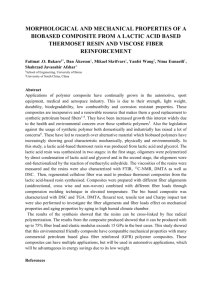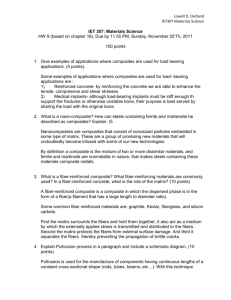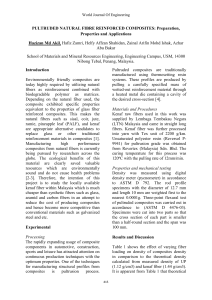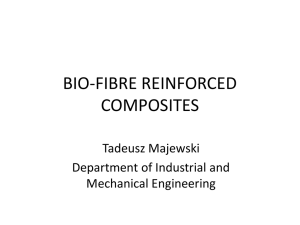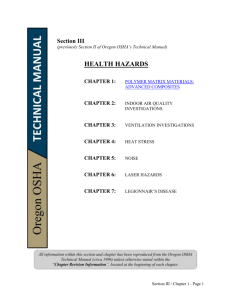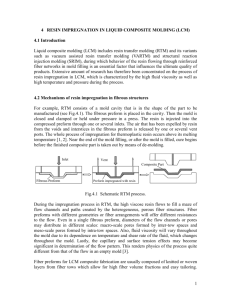Biobased Composites Prepared From a Lactic Acid Based
advertisement
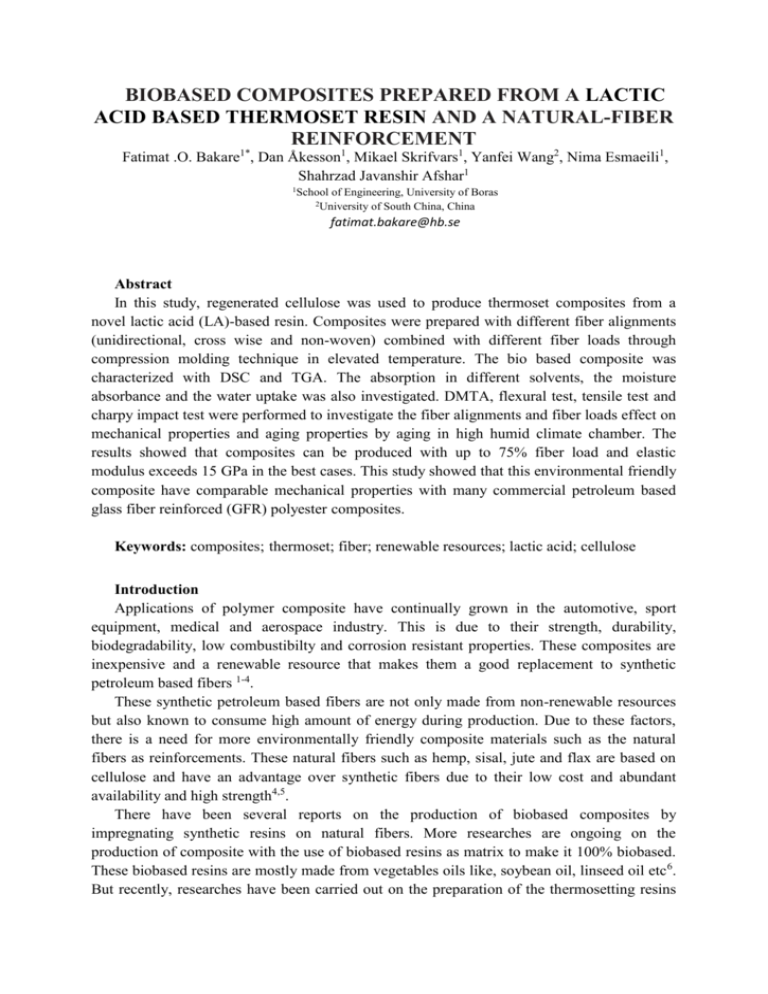
BIOBASED COMPOSITES PREPARED FROM A LACTIC ACID BASED THERMOSET RESIN AND A NATURAL-FIBER REINFORCEMENT Fatimat .O. Bakare1*, Dan Åkesson1, Mikael Skrifvars1, Yanfei Wang2, Nima Esmaeili1, Shahrzad Javanshir Afshar1 1School of Engineering, University of Boras of South China, China 2University fatimat.bakare@hb.se Abstract In this study, regenerated cellulose was used to produce thermoset composites from a novel lactic acid (LA)-based resin. Composites were prepared with different fiber alignments (unidirectional, cross wise and non-woven) combined with different fiber loads through compression molding technique in elevated temperature. The bio based composite was characterized with DSC and TGA. The absorption in different solvents, the moisture absorbance and the water uptake was also investigated. DMTA, flexural test, tensile test and charpy impact test were performed to investigate the fiber alignments and fiber loads effect on mechanical properties and aging properties by aging in high humid climate chamber. The results showed that composites can be produced with up to 75% fiber load and elastic modulus exceeds 15 GPa in the best cases. This study showed that this environmental friendly composite have comparable mechanical properties with many commercial petroleum based glass fiber reinforced (GFR) polyester composites. Keywords: composites; thermoset; fiber; renewable resources; lactic acid; cellulose Introduction Applications of polymer composite have continually grown in the automotive, sport equipment, medical and aerospace industry. This is due to their strength, durability, biodegradability, low combustibilty and corrosion resistant properties. These composites are inexpensive and a renewable resource that makes them a good replacement to synthetic petroleum based fibers 1-4. These synthetic petroleum based fibers are not only made from non-renewable resources but also known to consume high amount of energy during production. Due to these factors, there is a need for more environmentally friendly composite materials such as the natural fibers as reinforcements. These natural fibers such as hemp, sisal, jute and flax are based on cellulose and have an advantage over synthetic fibers due to their low cost and abundant availability and high strength4,5. There have been several reports on the production of biobased composites by impregnating synthetic resins on natural fibers. More researches are ongoing on the production of composite with the use of biobased resins as matrix to make it 100% biobased. These biobased resins are mostly made from vegetables oils like, soybean oil, linseed oil etc 6. But recently, researches have been carried out on the preparation of the thermosetting resins from lactic acid4,7. This biobased resin was prepared by direct condensation of pentaerythritol, itaconic acid and lactic acid. The obtained star-shaped molecules with pentaerythritol as the core molecule were end-capped by methacrylate groups. This resin had relatively good mechanical properties, but tests also showed that the resin had a relatively high viscosity. Another, polyester resin based on lactic acid and glycerol was produced and it showed a better mechanical properties and the viscosity was lower than the previous resin with pentaerythritol. In this study, the polyester resin based on lactic acid and glycerol was impregnated into a viscose fiber in woven and nonwoven shapes were investigated. Aproach The synthesis was done in two stages: The condensation reaction stage; branched oligomers of glycerol and lactic acid were prepared (with chain length n = 3, 7 and 10 lactic acid units) End-functionalization stage; the resin was reacted with methacrylic anhydride Figure 1: Reaction scheme of lactic acid and glycerol. Composite preparation The fibers were dried in the vacuum oven at 107˚C for two hours after cutting in desired sizes. The fiber was then prepared by manual layup in three ways: bidirection, unidirection of the woven fiber and the non woven fiber. The resin was blended with a thermal initiator and impregnation was done manually by handspray. Different fiber load were considered (65%, 70% and 75%) for the composite production. Then it was placed in a Rondol Press instrument to cure at 150˚C for 5 minutes. The composite was characterized using the tensile testing, flexural testing (3 point bending) and charpy impact testing. Results and Discussion Tensile Maximum Stress (MPa) Tensile properties 250 200 150 BD 100 UD 50 NW 0 65% 70% 75% Composites The tensile modulus and tensile max stress for different fiber alignments showed increases with increasing fiber load from 65 to 75% for UD and BD composites. Unlike non-woven that decreases by increasing fiber load from 65 to 75% which is a sign of improper impregnation for fiber loads higher than 65%. Flexural and Impact properties The storage modulus of different composite treatments showed considerable improvement in stiffness of composites compared to neat resin. The tan delta for composites from the neat resin to above 100˚C in all cases shows that it will be good use in many applications.The increase of tan delta with increasing fiber load can be interpreted as good interaction between fiber and matrix. Charpy Impact testing The absorbed energy for non-woven composites are much lower compared to aligned fiber composites. Sample investigation showed roughly soft fracture surface and no visible fiber pull out. It could be interpreted that fiber pull put occurred in very short length which leaded in lower absorbed dissipation. Conclusion The polyester resin based on lactic acid and glycerol could be used as matrix for cellulosic fibers with fiber load up to 70% and would yield good mechanical properties. Considering high renewable ratio and relatively low price for cellulosic fibers this resin shows promising properties for making strong affordable, bio degradable and renewable resourced composite for many applications. References 1 Kayode Adekunle, Dan Åkesson, and Mikael Skrifvars, J. Appl. Polym. Sci. 115 (6), 3137 (2010). 2 Erman Senoz, Joseph F. Stanzione,III, Kaleigh H. Reno, Richard P. Wool, Melissa E.N. Miller, J. Appl. Polym. Sci. 128: 983-989 (2013). 3 Yihong Shen, Shenghong Zhang, Hongjia Li, Yuan Ren, and Haichao Liu, Chemistry – A European Journal 16 (25), 7368 (2010). 4 Kayode Adekunle, Dan Åkesson, and Mikael Skrifvars, J. Appl. Polym. Sci. 116 (3), 1759 (2010). 5 Dan Åkesson, Mikael Skrifvars, Jukka Seppälä, and Minna Turunen, J. Appl. Polym. Sci. 119 (5), 3004 (2011). 6 Kayode Adekunle, Dan Åkesson, and Mikael Skrifvars, J. Appl. Polym. Sci. 115 (6), 3137 (2010). 7 Dan Åkesson, Mikael Skrifvars, Jukka Seppälä, Minna Turunen, Anna Martinelli, and Aleksandar Matic, J. Appl. Polym. Sci. 115 (1), 480 (2010).
